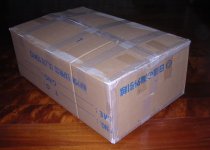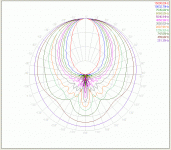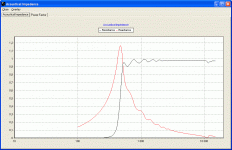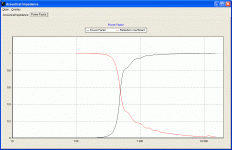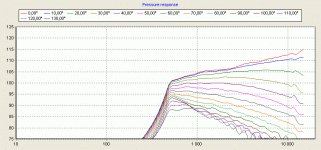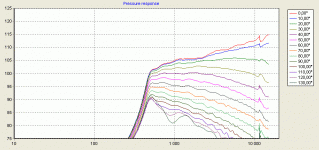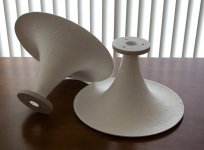Regarding Dr. Geddes' post, I remember reading an AES paper by the JVC team who developed a horn tweeter with a quasi-spherical shape (it looked like solid NC-milled aluminum) in an attempt to minimize diffraction. The paper came out in the early Eighties, so I'd have to dig through a lot of stuff to find it. If I come across this paper, I'll post parts of it.
The tweeter didn't look very big - it was definitely a HF tweeter - but the internal horn profile smoothly transitioned into a sphere, and the measurements were as flat and well-behaved as any tweeter out there. Much much better than the dreadful sectoral, Mantaray, and BiRadial horns that were the market standard back then.
As for the AH-425, one of the dimensional constraints was the inglorious fact that AUSPost has a hard limit on the overall size of the box (shown below, ready for shipping). If you ship by FedEx or UPS, the cost of postage rises from a reasonable AU$90 to an outrageous US$600. Perth, Australia is a long way from Denver, USA, and I am not skilled enough to do my own carpentry, much less fabricate a horn.
Part of the reason the project is taking so long is that I've only recently gained the physical ability to get up and down from the floor with a moderate amount of agility - bike riding around town has definitely helped over the summer. I'm hoping I'll be meeting a Denver-area constructor at the RMAF show who can take the project the rest of way into prototype form.
The tweeter didn't look very big - it was definitely a HF tweeter - but the internal horn profile smoothly transitioned into a sphere, and the measurements were as flat and well-behaved as any tweeter out there. Much much better than the dreadful sectoral, Mantaray, and BiRadial horns that were the market standard back then.
As for the AH-425, one of the dimensional constraints was the inglorious fact that AUSPost has a hard limit on the overall size of the box (shown below, ready for shipping). If you ship by FedEx or UPS, the cost of postage rises from a reasonable AU$90 to an outrageous US$600. Perth, Australia is a long way from Denver, USA, and I am not skilled enough to do my own carpentry, much less fabricate a horn.
Part of the reason the project is taking so long is that I've only recently gained the physical ability to get up and down from the floor with a moderate amount of agility - bike riding around town has definitely helped over the summer. I'm hoping I'll be meeting a Denver-area constructor at the RMAF show who can take the project the rest of way into prototype form.
Attachments
alternate drivers to vifa p13w-00-08
hi lynn,
I am a fan of your ariel transmission line speaker and am planning to make the 5s version , i would like your suggestion for an alternate driver since vifa p13w-00-08 is currently not available in my country.
kindly help in this regard.l
hi lynn,
I am a fan of your ariel transmission line speaker and am planning to make the 5s version , i would like your suggestion for an alternate driver since vifa p13w-00-08 is currently not available in my country.
kindly help in this regard.l
The P13W-00-08 has been discontinued by Vifa for several years, and is no longer available anywhere. There have have been other threads here in DIYAudio where other drivers have been suggested as candidates, with the primary requirement being smooth response, and freedom from out-of-band resonances - which rules out drivers with rigid cones made of metal, Kevlar, carbon-fiber, or other composites.
The Ariel is now 14 years old, and the drivers I originally started with don't have exact modern equivalents. I still have version 1.9 Ariels in my living room right now, but I don't quite enjoy the replacement Scan-Speak 9500 tweeters as much as the original 9000's with the sticky domes, and the replacement Vifa drivers I put in five years ago sound a little bit different as well - the speaker has subtly drifted away from the original design thanks to a number of small production changes in the drivers. The changes aren't huge, but the speaker does sound a bit different than what I originally intended.
When a manufacturer is the size of Bowers & Wilkins, they can demand the drivers be made their way, and compel the factory to make special versions that maintain the original specifications. When Vifa and Scan-Speak make a number of subtle production changes for versions sold into the DIY market, well, that's just too bad. They would like us to think that the newer version is always better, but that's only occasionally true - much of the time, the "improvements" are really disguised cost reductions, up to and including offshoring the manufacture to the lowest bidder in China.
I would like to advise simply visiting Zaph's page and selecting a MTM out of the many choices there, but speakers really do reflect the underlying philosophy and tastes of the designer. Zaph's designs certainly measure well, but I have no idea what they sound like.
My speakers are balanced for people who consider classical music their primary "reference" standard, but this is a minority view these days - I understand that classical music sales are down in the 1~2% range these days, and the sound and demo material at hifi shows reflects that.
If somebody at the upcoming RMAF show waved a check for $20,000 at me in return for spending the next six months designing a new and better version of the Ariel, I'd have to give it serious consideration. But I'm not seriously expecting that to happen, fun as the thought might be, so I'll keep working away at the concepts in the thread here.
The Ariel is now 14 years old, and the drivers I originally started with don't have exact modern equivalents. I still have version 1.9 Ariels in my living room right now, but I don't quite enjoy the replacement Scan-Speak 9500 tweeters as much as the original 9000's with the sticky domes, and the replacement Vifa drivers I put in five years ago sound a little bit different as well - the speaker has subtly drifted away from the original design thanks to a number of small production changes in the drivers. The changes aren't huge, but the speaker does sound a bit different than what I originally intended.
When a manufacturer is the size of Bowers & Wilkins, they can demand the drivers be made their way, and compel the factory to make special versions that maintain the original specifications. When Vifa and Scan-Speak make a number of subtle production changes for versions sold into the DIY market, well, that's just too bad. They would like us to think that the newer version is always better, but that's only occasionally true - much of the time, the "improvements" are really disguised cost reductions, up to and including offshoring the manufacture to the lowest bidder in China.
I would like to advise simply visiting Zaph's page and selecting a MTM out of the many choices there, but speakers really do reflect the underlying philosophy and tastes of the designer. Zaph's designs certainly measure well, but I have no idea what they sound like.
My speakers are balanced for people who consider classical music their primary "reference" standard, but this is a minority view these days - I understand that classical music sales are down in the 1~2% range these days, and the sound and demo material at hifi shows reflects that.
If somebody at the upcoming RMAF show waved a check for $20,000 at me in return for spending the next six months designing a new and better version of the Ariel, I'd have to give it serious consideration. But I'm not seriously expecting that to happen, fun as the thought might be, so I'll keep working away at the concepts in the thread here.
I can give a hint what kind of drivers I'd prefer if I were to modernize the Ariel: the Scan-Speak 15W8530-K00, or the Audio Technology drivers, with the C-Quenze 18 H 52 17 06 SD as a promising-looking midbass, and the Scan-Speak 6600 or Seas T25CF001 as the tweeter.
The CSD responses on Zaph's page tells you a lot about which drivers have resonant peaks and which don't. In theory, these upper-midrange peaks can be neutralized with notch filters, but it's better to avoid the need for them if at all possible.
The CSD responses on Zaph's page tells you a lot about which drivers have resonant peaks and which don't. In theory, these upper-midrange peaks can be neutralized with notch filters, but it's better to avoid the need for them if at all possible.
I have used the Peerless HDS 5" driver and it is very smooth. It doesn't have nasty resonances or breakups and has good sonic. It may be a good candidate for replacing the P13W-00-08. At 88dB sensitivity using two in a MTM would have 94dB. A good fit for the Ariel if the P13W-00-08 is no longer available.
Altec 288 FC conversion....
An externally hosted image should be here but it was not working when we last tested it.
An externally hosted image should be here but it was not working when we last tested it.
[Lynn Olson said:
Hi Charles, yes, I'd like to hear the JBL K2's. I live in Erie, no more than twenty minutes away from Boulder. You can see my e-mail address midway down the Nutshell High Fidelity website - let's make contact, I'd like to hear the big JBL's. I'm hoping they're in a somewhat higher class than the big TAD system I've heard so far. I appreciate the invite and would like to take you up on it.
I am partial agreement about the big woofers, which is why I'm keeping open the option of a pair of 12" drivers - again, used with a 700~850 Hz crossover. In this frequency range, I am more concerned about box modes than driver resonances.
The box modes in a big studio-monitor (or JBL K2) box are much harder to control, and to my ear, lend an annoying "droning" quality to the sound, a traditional part of the sound of big vintage loudspeakers. These modes are quite apparent when the drivers are pulled and you put your head in the box - you hear a droning, drumming quality to ambient sounds, and the box stuffing and damping, although reducing its magnitude, adds its own dull, murky quality to the droning sound. Many damping materials have their own sonic signature that overlays the basic box sound, resulting in a slow, sodden quality to the lower midrange and upper bass.
I used to be puzzled why these modes in the 300~800 Hz regions were so obstinately difficult to control, until I got MLSSA in 1991 and found it took 2 feet of a wide variety of damping materials to merely reduce the floor bounce by 20~25 dB. I started with what I thought was plenty of damping, several inches of the fancy commercial foam stuff, combined with several layers of audiophile-grade wool felt, and it only reduced the floor bounce by 5 dB or so! It was nearly worthless!
Now, above 2 kHz, then the commercial stuff started to make a difference that was more worthwhile, particularly if you wanted to reduce the slap off the back of the cabinet. But frankly, anything I could buy on the market, had only the slightest effect in reducing the box modes - and the bigger the cabinet, of course, the lower in frequencies these modes are, and the less effective any type of damping, at any price. So all of the fancy damping we see in big box cabinets is mostly effective above 1 kHz, and does surprisingly little below that frequency. What it does do, though, is add odd colorations of its own, which is why lightly damped old-school speakers can sound better than modern, heavily-damped speakers. It's one of those pick-your-coloration things.
All it takes is a little playing around with MLSSA, or any MLS program, and looking at what it really takes to absorb the floor bounce. Since MLS systems can examine the frequency response of the bounce itself (by gating away the direct sound from the loudspeaker), you can examine at leisure what various damping material do in terms of absorption vs frequency. Carpeting, for example, does nothing below 8 kHz - it might as well be glass.
It was this discovery that made me realize just how hopeless the situation with conventional box speakers really is. The only way to get around it is confine the box speaker to very low frequencies (below the first mode) and use a sharp-cutoff crossover to avoid contaminating the more critical region of the spectrum. Otherwise, the box is going to result in murky, opaque, and congested bass - I suspect much of the merit of transmission-line speakers amounts to little more than clever control of box modes in the 300 to 800 Hz region. That's what I had in mind with the Ariel - it was the box-mode region I was most interested in, not the deep bass. Even so, transmission lines have their own set of awkward compromises in this frequency region.
Although I grant that big drivers in the 12 to 15-inch range are starting to get into trouble, with the spider and surround being the first resonance to appear, I feel the box modes are the most prominent and objectionable - and due to the lack of good LF absorbers, the hardest to control. My instinct is that more than 20~30 dB of smooth, broadband absorption is needed, and existing damping and absorbing materials just don't provide that in the box-mode region. Thus, the proverbial "box" coloration which is so noticeably absent in bass horns and dipoles - since we are all so used to this particular coloration, it is most noticeable when it disappears.
For me, the charm of OB isn't so much the dipole radiation pattern, with the claim to less room coloration (which I am not all that sure of), but the more genuine advantage of side-stepping a prominent coloration in a very important frequency range - upper bass and lower midrange. True, driver colorations remain, but I feel these are much milder in the 300~800 Hz region than the much more noticeable 1~4 kHz region, where small-format midbass drivers are commonly used.
Hi all.
nice thread
rule-of-thumb: absorbtion thickness = 1 wavelength or more.
myhrrhleine said:
rule-of-thumb: absorption thickness = 1 wavelength or more.
I agree. To think 1" of "audiophile" foam lining the walls of a typical cabinet can have much effect on the dominant (typically top-to-bottom) standing-wave mode is absurd. And these modes are much worse in cylindrical and spherical enclosures, something I found out the hard way when I built a prototype low-diffraction speaker that looked like a giant vitamin capsule. It had low diffraction all right - the speakers disappeared completely in a dark room - but the high-Q dominant cabinet mode was impossible to remove.
mige0 said:Only need the FR without driver.
Please don't feel forced - waiting for some more days or not shouldn't make the hell of a difference - this thread started one and a half years ago...

Sorry for coming back late. I've been quite busy the last two weeks.
Well, here's the polar plot for AH-425.
Bjørn
Attachments
Finally, here are the frequency response curves without driver for the AH-425. This is the SPL at a 3m distance from the horn mouth, at different angles, for a constant volume velocity of 1m/s at the throat. The SPL response will of course be different when a driver is used, and not a constant velocity source, but the relative levels will be the same.
There will however be some differences due to differences in the velocity distribution at the throat, but this simulation does at least give you a general idea of how the horn performs. In the simulation a plane wavefront at the throat, with uniform velocity distribution, is assumed.
Bjørn
There will however be some differences due to differences in the velocity distribution at the throat, but this simulation does at least give you a general idea of how the horn performs. In the simulation a plane wavefront at the throat, with uniform velocity distribution, is assumed.
Bjørn
Attachments
Recently I have also been able to simulate horns in BEM as thin shells, which is more like how the Azurahorns are made. The difference in throat impedance is small, the shell has slighly more ripple.
But there are larger differences in the frequency response curves, they are not quite as smooth as the simulations where the horn has been enclosed in a cylinder.
Attached is the frequency respone plots for constant throat velocity (no driver), 3m distance, for the shell version of the AH-425.
Bjørn
But there are larger differences in the frequency response curves, they are not quite as smooth as the simulations where the horn has been enclosed in a cylinder.
Attached is the frequency respone plots for constant throat velocity (no driver), 3m distance, for the shell version of the AH-425.
Bjørn
Attachments
drivers for ariel
hi guys,
for my ariel 5s version.....
with great amount of persuassion i got 2 pairs of peerless fabrikerne(india) 5.5inch mid woofers with vented magnet and spider but to my dismay it is a 4ohm driver also there were no technical details given by the supplier(torvin).... they say they will get it soon..huh....kindly help me the part no is 3253 and its a sandwiched papercone driver.....with stunted frame.....kindly help with thiele small parameters....
hi guys,
for my ariel 5s version.....
with great amount of persuassion i got 2 pairs of peerless fabrikerne(india) 5.5inch mid woofers with vented magnet and spider but to my dismay it is a 4ohm driver also there were no technical details given by the supplier(torvin).... they say they will get it soon..huh....kindly help me the part no is 3253 and its a sandwiched papercone driver.....with stunted frame.....kindly help with thiele small parameters....
As painful as it is, I'd return the drivers - the Ariel can't work with 4 ohm drivers.
It sounds like the new drivers have nothing in common with the original driver except the frame size - paper cone, 4 ohms, most likely completely different construction. The originals are 8 ohms, a fairly sophisticated polypropylene cone, and a soft rubber dustcap.
It sounds like the new drivers have nothing in common with the original driver except the frame size - paper cone, 4 ohms, most likely completely different construction. The originals are 8 ohms, a fairly sophisticated polypropylene cone, and a soft rubber dustcap.
No, they are not constant-directivity. Similar to a Tractrix in the overall characteristic, although noticeably smoother looking. The modern low-diffraction constant-directivity horns are the Geddes OS waveguide, the quadratic-throat, or conicals with a curved transition region between the exit of the compression driver and the entrance to the conical section. The older, intentional-diffraction constant-directivity horns have kinks in the profile, like the Altec Mantaray or JBL Bi-Radial. Constant-directivity horns typically require an upward tilt to the equalization (boost EQ) for flat response at the listening position.
If this version of the LeCleac'h is listened to on-axis, it will need a moderate amount of down-shelving for flat response; if little or no equalization is desired, they should be aimed at a spot several feet in front of the listener. In practice, there should be an angle that has the best impulse response, and that remains to be determined by measurement.
If this version of the LeCleac'h is listened to on-axis, it will need a moderate amount of down-shelving for flat response; if little or no equalization is desired, they should be aimed at a spot several feet in front of the listener. In practice, there should be an angle that has the best impulse response, and that remains to be determined by measurement.
- Home
- Loudspeakers
- Multi-Way
- Beyond the Ariel
